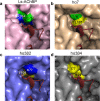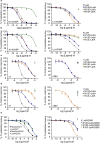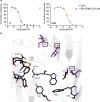Structural mechanisms for α-conotoxin activity at the human α3β4 nicotinic acetylcholine receptor
- PMID: 28361878
- PMCID: PMC5374441
- DOI: 10.1038/srep45466
Structural mechanisms for α-conotoxin activity at the human α3β4 nicotinic acetylcholine receptor
Abstract
Nicotinic acetylcholine receptors (nAChR) are therapeutic targets for a range of human diseases. α-Conotoxins are naturally occurring peptide antagonists of nAChRs that have been used as pharmacological probes and investigated as drug leads for nAChR related disorders. However, α-conotoxin interactions have been mostly characterised at the α7 and α3β2 nAChRs, with interactions at other subtypes poorly understood. This study provides novel structural insights into the molecular basis for α-conotoxin activity at α3β4 nAChR, a therapeutic target where subtype specific antagonists have potential to treat nicotine addiction and lung cancer. A co-crystal structure of α-conotoxin LsIA with Lymnaea stagnalis acetylcholine binding protein guided the design and functional characterisations of LsIA analogues that identified the minimum pharmacophore regulating α3β4 antagonism. Interactions of the LsIA R10F with β4 K57 and the conserved -NN- α-conotoxin motif with β4 I77 and I109 conferred α3β4 activity to the otherwise inactive LsIA. Using these structural insights, we designed LsIA analogues with α3β4 activity. This new understanding of the structural basis of protein-protein interactions between α-conotoxins and α3β4 may help rationally guide the development of α3β4 selective antagonists with therapeutic potential.
Conflict of interest statement
The authors declare no competing financial interests.
Figures





Similar articles
-
Key Structural Determinants in the Agonist Binding Loops of Human β2 and β4 Nicotinic Acetylcholine Receptor Subunits Contribute to α3β4 Subtype Selectivity of α-Conotoxins.J Biol Chem. 2016 Nov 4;291(45):23779-23792. doi: 10.1074/jbc.M116.730804. Epub 2016 Sep 19. J Biol Chem. 2016. PMID: 27646000 Free PMC article.
-
Molecular determinants of α-conotoxin potency for inhibition of human and rat α6β4 nicotinic acetylcholine receptors.J Biol Chem. 2018 Nov 16;293(46):17838-17852. doi: 10.1074/jbc.RA118.005649. Epub 2018 Sep 24. J Biol Chem. 2018. PMID: 30249616 Free PMC article.
-
Alanine scan of α-conotoxin RegIIA reveals a selective α3β4 nicotinic acetylcholine receptor antagonist.J Biol Chem. 2015 Jan 9;290(2):1039-48. doi: 10.1074/jbc.M114.605592. Epub 2014 Nov 19. J Biol Chem. 2015. PMID: 25411242 Free PMC article.
-
The Structural Features of α-Conotoxin Specifically Target Different Isoforms of Nicotinic Acetylcholine Receptors.Curr Top Med Chem. 2015;16(2):156-69. doi: 10.2174/1568026615666150701114831. Curr Top Med Chem. 2015. PMID: 26126912 Review.
-
Residues Responsible for the Selectivity of α-Conotoxins for Ac-AChBP or nAChRs.Mar Drugs. 2016 Oct 11;14(10):173. doi: 10.3390/md14100173. Mar Drugs. 2016. PMID: 27727162 Free PMC article. Review.
Cited by
-
Interactions of the α3β2 Nicotinic Acetylcholine Receptor Interfaces with α-Conotoxin LsIA and its Carboxylated C-terminus Analogue: Molecular Dynamics Simulations.Mar Drugs. 2020 Jul 3;18(7):349. doi: 10.3390/md18070349. Mar Drugs. 2020. PMID: 32635340 Free PMC article.
-
Potency- and Selectivity-Enhancing Mutations of Conotoxins for Nicotinic Acetylcholine Receptors Can Be Predicted Using Accurate Free-Energy Calculations.Mar Drugs. 2021 Jun 25;19(7):367. doi: 10.3390/md19070367. Mar Drugs. 2021. PMID: 34202022 Free PMC article.
-
Characterization of an α 4/7-Conotoxin LvIF from Conus lividus That Selectively Blocks α3β2 Nicotinic Acetylcholine Receptor.Mar Drugs. 2021 Jul 17;19(7):398. doi: 10.3390/md19070398. Mar Drugs. 2021. PMID: 34356823 Free PMC article.
-
Conotoxins from sea snails as potential bone remodeling disruptors.JBMR Plus. 2025 Feb 10;9(8):ziaf025. doi: 10.1093/jbmrpl/ziaf025. eCollection 2025 Aug. JBMR Plus. 2025. PMID: 40642479 Free PMC article.
-
ConoMode, a database for conopeptide binding modes.Database (Oxford). 2020 Jan 1;2020:baaa058. doi: 10.1093/database/baaa058. Database (Oxford). 2020. PMID: 32754758 Free PMC article.
References
-
- Corringer P.-J., Novère N. L. & Changeux J.-P. Nicotinic receptors at the amino acid level. Annu Rev Pharmacol Toxicol 40, 431–458 (2000). - PubMed
-
- Dani J. A. & Bertrand D. Nicotinic acetylcholine receptors and nicotinic cholinergic mechanisms of the central nervous system. Annu. Rev. Pharmacol. Toxicol. 47, 699–729 (2007). - PubMed
-
- Dani J. A. Overview of nicotinic receptors and their roles in the central nervous system. Biol Psychiatry 49, 166–174 (2001). - PubMed
-
- Hurst R., Rollema H. & Bertrand D. Nicotinic acetylcholine receptors: from basic science to therapeutics. Pharmacol Thera 137, 22–54 (2013). - PubMed
Publication types
MeSH terms
Substances
LinkOut - more resources
Full Text Sources
Other Literature Sources

